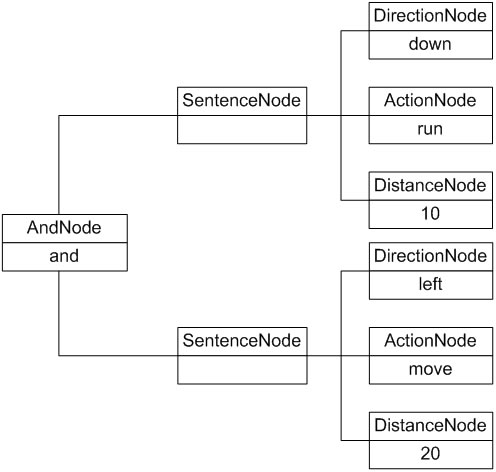自定义语言的实现——解释器模式(四)
完整解决方案
为了能够解释机器人控制指令,Sunny 软件公司开发人员使用解释器模式来设计和实现机器人控制程序。针对五条文法规则,分别提供五个类来实现,其中终结符表达式 direction、action 和 distance 对应 DirectionNode 类、ActionNode 类和 DistanceNode 类,非终结符表达式 expression 和 composite 对应 SentenceNode 类和 AndNode 类。
我们可以通过抽象语法树来表示具体解释过程,例如机器人控制指令“down run 10 and left move 20”对应的抽象语法树如图所示:

机器人控制程序实例基本结构如图所示:

在图中,AbstractNode 充当抽象表达式角色,DirectionNode、ActionNode 和 DistanceNode 充当终结符表达式角色,AndNode 和 SentenceNode 充当非终结符表达式角色。完整代码如下所示:
//注:本实例对机器人控制指令的输出结果进行模拟,将英文指令翻译为中文指令,实际情况是调用不同的控制程序进行机器人的控制,包括对移动方向、方式和距离的控制等
import java.util.*;
//抽象表达式
abstract class AbstractNode {
public abstract String interpret();
}
//And解释:非终结符表达式
class AndNode extends AbstractNode {
private AbstractNode left; //And的左表达式
private AbstractNode right; //And的右表达式
public AndNode(AbstractNode left, AbstractNode right) {
this.left = left;
this.right = right;
}
//And表达式解释操作
public String interpret() {
return left.interpret() + "再" + right.interpret();
}
}
//简单句子解释:非终结符表达式
class SentenceNode extends AbstractNode {
private AbstractNode direction;
private AbstractNode action;
private AbstractNode distance;
public SentenceNode(AbstractNode direction,AbstractNode action,AbstractNode distance) {
this.direction = direction;
this.action = action;
this.distance = distance;
}
//简单句子的解释操作
public String interpret() {
return direction.interpret() + action.interpret() + distance.interpret();
}
}
//方向解释:终结符表达式
class DirectionNode extends AbstractNode {
private String direction;
public DirectionNode(String direction) {
this.direction = direction;
}
//方向表达式的解释操作
public String interpret() {
if (direction.equalsIgnoreCase("up")) {
return "向上";
}
else if (direction.equalsIgnoreCase("down")) {
return "向下";
}
else if (direction.equalsIgnoreCase("left")) {
return "向左";
}
else if (direction.equalsIgnoreCase("right")) {
return "向右";
}
else {
return "无效指令";
}
}
}
//动作解释:终结符表达式
class ActionNode extends AbstractNode {
private String action;
public ActionNode(String action) {
this.action = action;
}
//动作(移动方式)表达式的解释操作
public String interpret() {
if (action.equalsIgnoreCase("move")) {
return "移动";
}
else if (action.equalsIgnoreCase("run")) {
return "快速移动";
}
else {
return "无效指令";
}
}
}
//距离解释:终结符表达式
class DistanceNode extends AbstractNode {
private String distance;
public DistanceNode(String distance) {
this.distance = distance;
}
//距离表达式的解释操作
public String interpret() {
return this.distance;
}
}
//指令处理类:工具类
class InstructionHandler {
private String instruction;
private AbstractNode node;
public void handle(String instruction) {
AbstractNode left = null, right = null;
AbstractNode direction = null, action = null, distance = null;
Stack stack = new Stack(); //声明一个栈对象用于存储抽象语法树
String[] words = instruction.split(" "); //以空格分隔指令字符串
for (int i = 0; i < words.length; i++) {
//本实例采用栈的方式来处理指令,如果遇到“and”,则将其后的三个单词作为三个终结符表达式连成一个简单句子SentenceNode作为“and”的右表达式,而将从栈顶弹出的表达式作为“and”的左表达式,最后将新的“and”表达式压入栈中。 if (words[i].equalsIgnoreCase("and")) {
left = (AbstractNode)stack.pop(); //弹出栈顶表达式作为左表达式
String word1= words[++i];
direction = new DirectionNode(word1);
String word2 = words[++i];
action = new ActionNode(word2);
String word3 = words[++i];
distance = new DistanceNode(word3);
right = new SentenceNode(direction,action,distance); //右表达式
stack.push(new AndNode(left,right)); //将新表达式压入栈中
}
//如果是从头开始进行解释,则将前三个单词组成一个简单句子SentenceNode并将该句子压入栈中
else {
String word1 = words[i];
direction = new DirectionNode(word1);
String word2 = words[++i];
action = new ActionNode(word2);
String word3 = words[++i];
distance = new DistanceNode(word3);
left = new SentenceNode(direction,action,distance);
stack.push(left); //将新表达式压入栈中
}
}
this.node = (AbstractNode)stack.pop(); //将全部表达式从栈中弹出
}
public String output() {
String result = node.interpret(); //解释表达式
return result;
}
}工具类 InstructionHandler 用于对输入指令进行处理,将输入指令分割为字符串数组,将第 1 个、第 2 个和第 3 个单词组合成一个句子,并存入栈中;如果发现有单词“and”,则将“and”后的第 1 个、第 2 个和第 3 个单词组合成一个新的句子作为“and”的右表达式,并从栈中取出原先所存句子作为左表达式,然后组合成一个 And 节点存入栈中。依此类推,直到整个指令解析结束。
编写如下客户端测试代码:
class Client {
public static void main(String args[]) {
String instruction = "up move 5 and down run 10 and left move 5";
InstructionHandler handler = new InstructionHandler();
handler.handle(instruction);
String outString;
outString = handler.output();
System.out.println(outString);
}
}编译并运行程序,输出结果如下:
向上移动 5 再向下快速移动 10 再向左移动 5
上一篇: 解释器模式概述
下一篇: 再谈 Context 的...